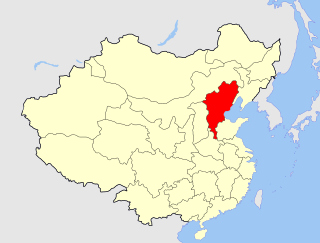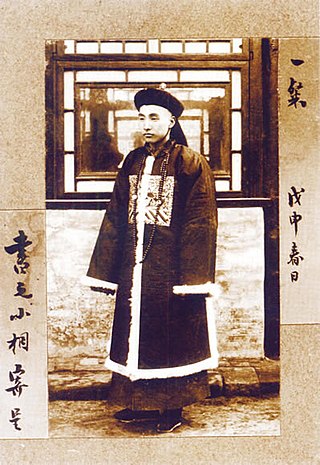A prefecture is an administrative jurisdiction traditionally governed by an appointed prefect. This can be a regional or local government subdivision in various countries,or a subdivision in certain international church structures,as well as in antiquity a Roman district.
A subprefecture is an administrative division of a country that is below prefecture or province.

Chahar,also known as Chaha'er,Chakhar or Qahar,was a province of the Republic of China in existence from 1912 to 1936,mostly covering territory in what is part of Eastern Inner Mongolia. It was named after the Chahar Mongols.

Zhili,alternately romanized as Chihli,was a northern administrative region of China since the 14th-century that lasted through the Ming dynasty and Qing dynasty until 1911,when the region was dissolved,converted to a province,and renamed Hebei in 1928.

Prefectures are one of four types of prefecture-level divisions in China,the second-level administrative division in the country. While at one time prefectures were the most common prefecture-level division,they are in the process of being abolished and only seven formally-designated prefectures remain.

A yamen was the administrative office or residence of a local bureaucrat or mandarin in imperial China,Korea,and Vietnam. A yamen can also be any governmental office or body headed by a mandarin,at any level of government:the offices of one of the Six Ministries is a yamen,but so is a prefectural magistracy. The term has been widely used in China for centuries,but appeared in English during the Qing dynasty.

Zongdu were the managers supervising provincial governors in Ming and Qing China. One viceroy usually administered several provinces and was in charge of all affairs of military,food,wages,rivers,and provincial governors within their region of jurisdiction. Viceroys was appointed by and directly reported to the Emperor.

The Viceroy of Zhili,officially in Chinese as the Governor-General of the Directly Subordinate Province and Other Local Areas,in Charge of Military Affairs,Food and Wages,Management of Rivers and Governor Affairs, was one of eight regional Viceroys during the Qing dynasty. The Viceroy of Liangjiang had jurisdiction of military,civil,and political affairs over then Zhili Province. The Governor's Office sat in then Zhili Province's Baoding Prefecture City.

Yutian County is a county in the northeast of Hebei province,China,and is under the administration of the prefecture-level city of Tangshan,bordering Tianjin to the north and west. It is located approximately 55 kilometres (34 mi) northwest of Tangshan and 110 km (68 mi) east of Beijing,lying on China National Highway 102. It has an area of 1,169 km2 (451 sq mi),and as of 2012,a population of approximately 680,000.
Qian'an is a county-level city in the northeast of Hebei province,China. It is under the administration of the prefecture-level city of Tangshan. The city spans an area of 1,227 square kilometres (474 sq mi),and has a population of 775,813 as of 2021.

A county,constitutionally known as a hsien,is a de jure second-level administrative division unit in the Republic of China (Taiwan). Under the administrative structure of Taiwan,it is with the same level of a provincial city.

Taiping Prefecture was an administrative region of China during the Ming (1368–1644) and Qing (1644–1911) dynasties that spanned roughly the areas of the modern day cities of Ma'anshan and Wuhu in Anhui Province. During the Ming dynasty the prefecture was classified as part of Southern Zhili and later came under the administration of Anhui Province during the Qing dynasty. Taiping Prefecture consisted of the three counties of Dangtu,Wuhu,and Fanchang. It was abolished in 1912 with the advent of the Republic of China.

"Beijing" is from pinyin Běijīng, which is romanized from 北京,the Chinese name for this city. The pinyin system of transliteration was approved by the Chinese government in 1958,but little used until 1979. It was gradually adopted by various news organizations,governments,and international agencies over the next decade.

Taiwan Prefecture or Taiwanfu was a prefecture of Taiwan during the Qing dynasty. The prefecture was established by the Qing government in 1684,after the island came under Qing dynasty rule in 1683 following its conquest of the Kingdom of Tungning. The Taiwan Prefecture Gazetteer documented it as part of Fujian Province. The Gazetteer was completed by Gao Gonggan in 1695,the 34th year of the reign of the Kangxi Emperor. With the development and population growth of Taiwan during the Qing Era,the scope of Taiwan Prefecture was also varied over time. Following the establishment of Fujian-Taiwan Province in 1887,the prefecture correspondingly became a subdivision under the newly founded province.
Yanzhou Prefecture was an administrative unit (prefecture) in Zhejiang Province of China during the Ming and Qing Dynasties. It was abolished in 1912,soon after the fall of the Qing. The territory of the former Yanzhou Prefecture is now part of the Hangzhou Prefecture-level city.
Fu is a traditional administrative division of Chinese origin used in the East Asian cultural sphere,translated variously as commandery,prefecture,urban prefecture,or city. They were first instituted as a regular form of administrative division of China's Tang Empire,but were later adopted in Vietnam,Japan and Korea. At present,only two fu still remain:the prefectures of Kyoto and Osaka in Japan.
Han Weiji,courtesy name Zhenzi,was a Chinese official who lived in the Qing dynasty. Han was born in Xiaotian Village,Zichuan County,Shandong Province,China. Han was a tong jinshi who obtained the third highest position in his class in the imperial examination. During the reign of the Kangxi Emperor,Han served as a county magistrate in Wenxi County,Shanxi and Boye County,Zhili.
Jingzhao was a historical region centered on the ancient Chinese capital of Chang'an.

The administration of territory in dynastic China is the history of practices involved in governing the land from the Qin dynasty to the Qing dynasty (1644–1912).

The Qing dynasty (1644–1912) was the last imperial dynasty of China. The early Qing emperors adopted the bureaucratic structures and institutions from the preceding Ming dynasty but split rule between the Han and Manchus with some positions also given to Mongols. Like previous dynasties,the Qing recruited officials via the imperial examination system until the system was abolished in 1905. The Qing divided the positions into civil and military positions,each having nine grades or ranks,each subdivided into a and b categories. Civil appointments ranged from an attendant to the emperor or a grand secretary in the Forbidden City (highest) to being a prefectural tax collector,deputy jail warden,deputy police commissioner,or tax examiner. Military appointments ranged from being a field marshal or chamberlain of the imperial bodyguard to a third class sergeant,corporal or a first or second class private.












